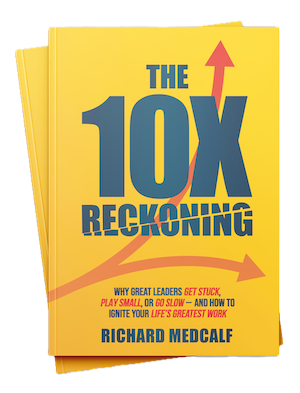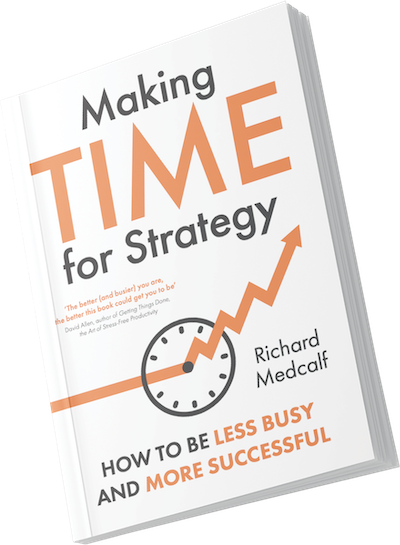Exponential leadership is my obsession.
In fact, I’m on a mission to help the world’s top leaders create and seize breakthrough opportunities that transform themselves, their businesses and, ultimately, change the world.
This means abandoning incremental goals and ways of thinking, and this shift from incremental to exponential is why I wrote Making TIME For Strategy and The 10X Reckoning.
So I was delighted to receive an advance copy of “The Science of Scaling: Grow Your Business Bigger and Faster Than You Think Possible” by Benjamin Hardy. It covers a high-level scaling methodology in the form of a mental model that is important for every ambitious entrepreneur.
Here’s what I intend to be an ultimate guide to the book, a detailed review along with my insights, actions, and takeaways.
Let’s get stuck in.

I. Introduction to “The Science of Scaling” by Benjamin Hardy
“The Science of Scaling” is a 2025 book by Dr Benjamin Hardy, a business author most recently recognised for his trilogy of books in collaboration with Dan Sullivan of Strategic Coach, including "Who Not How" and "10X is Easier Than 2X."
The goal of this book is to encourage entrepreneurial leaders to dramatically scale their business by setting what he refers to as "impossible goals," and then using those as a mechanism to elevate strategic focus.
This, of course, is very closely aligned to the work that I do day in and day out with high-level founders and CEOs. So I was very interested to dive into this book.
The book is squarely aimed at business owners/entrepreneurs or perhaps chief executives with a large amount of managerial leeway, as mid-level managers will find they don't have the necessary freedom to implement these recommendations.
The book covers the following key themes:
- Why you should set a goal so big you think it's impossible
- Why you should compress your timeline so that you think it's impossible
- Why you need to let go of 80% or more of the things that you're currently doing
- Why you're not as focused as you think, and why you need to simplify your system
- Why the biggest need is to engineer a focused path and a scalable model and say no to many projects
- Why you need to upgrade the people in your business in order to achieve your impossible goals
The book was released in July 2025 by Hay House Publishing.
II. “The Science of Scaling” – overview & review of the book
In this section, I'll walk you through a high-level summary of each chapter from “The Science of Scaling” and explain the main arguments that Benjamin Hardy offers.
PART 1: CHANGE YOUR FRAME
Chapter 1: Set a Goal So Big You Think It's Impossible
Most businesses end up setting several competing goals, each of which are generally actually fairly modest in nature, because they're unclear about what they're actually trying to accomplish.
But once you commit to a seemingly impossible goal, it forces you to simplify your focus and eliminate everything that doesn't contribute to that goal.
For example, the book describes one business owner who decided to scale from 10 to 100 clients in 90 days, but then realised this just required putting more effort to her current strategy and, thus, was ‘incremental.’ When she decided to commit to scaling to 1000 clients instead, radically different strategies were needed.
In many ways, this is a rephrasing of Benjamin Hardy's previous book, "10X is Easier Than 2X" which he wrote in collaboration with Dan Sullivan. It's the same message: a 10X goal forces radical focus, whereas incremental goals allow you to keep all the complexity of your current system.
CHAPTER SUMMARY
Chapter 2: Set a Timeline So Short You Think It's Impossible
Whilst organisations can have big, hairy and audacious goals (BHAGs), these are very often described as long-term objectives, perhaps 10 years or so into the future. And individuals can have similar long-term goals. However, when the timeline for these goals is far out, they make no demands on how you act in the present, and therefore are not actually serving you.
This reminds me of one of my clients who had a 10-year plan to change his industry, but was still mired in the operations of his core business. After working together for a couple of months, he got clear that he could and should achieve it in 3 years, and he immediately started making big moves - mergers, acquisitions, etc. - to do it.
When you start to shorten the time frame of your goal, to say within three years or even less, then you'll start to feel the need to do something very different, starting tomorrow morning or even today.
What happens when you shorten the time frame is that the bottleneck to achieving your goal becomes abundantly clear and you are forced to solve what Dr Richard Rumelt calls "the crux of the problem."
As Hardy says, the purpose of the impossible goal and the deadline is that the filter for your action becomes extremely intense. If you have only 18 months to do what you thought you had 10 to 15 years to accomplish, you can't waste your time on nonsense.
CHAPTER SUMMARY
PART 2: RAISE YOUR FLOOR
Chapter 3: Be More Honest with Yourself and Quit the Wrong Stuff Faster
Hardy introduces the term "the floor," which represents the minimum standard that you are willing to accept. This could be the minimum revenues from a client, the minimum performance from a team member, the minimum opportunity size worth pursuing.
If you don't raise your floor, then you find yourself mired in all the existing complexity of your business.
But when you raise your floor and reject anything below it, then you only engage with projects, customers and people who can actually move the needle.
This reminds me of a client that I recently worked with. I encouraged him to raise the floor on his client base. Whereas his business was originally serving many customers who only spent five to 20k per year, we realised that the only way for him to achieve 10X growth in the next three years was to refocus exclusively on the handful of customers who were already paying 1 million per year or more, and those who had the potential to scale to that level within a six to 12 month time frame.
CHAPTER SUMMARY
Chapter 4: Simplify Your System
When your business is complicated, it's incredibly hard to make bold moves and re-imagine things. But when you create simplicity, you create focus.
Think of when Steve Jobs returned to Apple in 1997 and culled their 350 products down to around 10. He was able to turn around a billion dollar per year loss into a $309 million profit in one year.
Very often, leaders convince themselves that they are focused, whereas in fact, they are managing a whole ecosystem of related goals and projects that they've convinced themselves are necessary to hit their current objectives. But once you decide what you really need to optimize for, you can simplify your system accordingly.
For example, Hardy himself abandoned his YouTube channel, which was doing incredibly well, because he realised his ultimate goal was not to be a YouTuber, but to be an author. Another leader sold two-thirds of his client base in order to focus on the clients that were generating $10 million or more.
CHAPTER SUMMARY
PART 3: ACCELERATE YOUR FOCUS
Chapter 5: Do the Work to Engineer a Focused Path and Scalable Model
I found this chapter didn’t break much new ground. It maintains the radical focus theme, but applies it more to the overall business model.
The two key messages are, firstly, that if you’re not focused, you’re going to stagnate and falter. And secondly, if you don’t choose a focused path, and keep the main thing the main thing, then you won’t scale.
So instead of following best practices of what everybody else is doing, find a unique perspective and solution, and create a business model where you're scaling probably just one core thing.
CHAPTER SUMMARY
Chapter 6: Build Something That Can Scale Beyond Yourself
However, many entrepreneurs are more committed to maintaining the status quo and avoiding difficult conversations than they are to truly scaling.
Once you have established a new and radically higher floor, in other words, higher standards in your business, then you need to see who engages at that level of that new floor, and who is consistently going under the floor. For example, working on smaller issues or dealing with clients or problems that are now below the floor.
It would also be important to establish the seemingly impossible goal and watch how your team reacts when you present it to them. Some will respond with commitment and serious attention, and some will respond with pushback and a demand for the status quo.
This chapter is drawing heavily on Hardy's previous book "Who Not How." Here he introduces the idea of partnering with "super whos" - highly leveraged individuals and meshing their visions together, where everybody is bought in, unified and incentivised. Often it's just one personal partner who can 10X or more your vision. As he says, "You're just one super who away from scaling."
CHAPTER SUMMARY
III. Key takeaways and actionable insights from “The Science of Scaling”
This book is actually surprisingly brief and actually pretty simple. Here for me are the essential action points from the book:
- Remember that, as Hardy already told us in his last book, 10X is easier than 2X! Set an impossible goal, what I call a quantum leap, that requires you to start playing a radically different game.
- Reject all the mediocre, conflicting goals you currently have, and let this one goal dominate your strategic thinking and execution focus.
- Make sure that your goal is urgent enough by reducing the timeframe until it starts to force you to make big changes immediately. If you feel you can get to it next quarter, it's not urgent enough.
- Take a good long, hard look at everything going on in your life, your leadership and your business, and eliminate all the things which do not have the potential to get you to your impossible goal. This is what raising the floor is all about.
- As you do this, be prepared to make radical changes to your business by simplifying it, eliminating products, services, customers and processes which do not ultimately drive your impossible goal.
- Make sure your business model aligns to your impossible goal. Pursue one game-changing solution to a sharp problem with world-class excellence.
- Ruthlessly hold the floor and hold your team to the floor that you have set, swapping out people who drop below the floor with superstar players who are ready to commit and work at the new level.
- Look for "super who" partners who are aligned with your impossible goal, and who can make it happen, perhaps in a heartbeat.
IV. “The Science of Scaling”: strengths and limitations of the book
It's an inspiring call to action
Like its predecessor, “The Science of Scaling” is an inspiring read, making a strong case for setting audacious goals and then radically making time to actually deliver on them through simplification and focus.
The biggest personal insights for me were the reminder to look brutally at all the paths which are not taking you towards your impossible goal, and the reminder to find "super whos" to accelerate your mission.
Overall, the book does a good job at laying out the three-part framework of Frame (i.e. set an impossible goal), Floor (radically simplify and raise standards) and Focus (build a business model and team who can deliver on it).
There are some great stories
There are a lot of stories and examples in this book which do bring everything to life.
“The Science of Scaling” does seem to be somewhat of a sales pitch for Hardy's own consulting program, and many of the stories are presented in that light, but they are still good reads and put flesh on the bone of the key framework.
The book doesn't deliver on the how
As I said earlier, this book is really whetting people's appetite to work with Hardy's team in his new consulting business, which perhaps explains the lack of practical advice.
So the book is a great mental reframe around the three key areas of FRAME-FLOOR-FOCUS, but at a high level, it does fundamentally amount to: set a huge goal and radically simplify and focus to achieve it.
What the book does not go into is actually all the difficulties of making that happen:
- the leadership challenges that you'll face with your team (how can I best get them on board?)
- the fears, doubts and concerns that you will have as a leader to actually make this shift happen (e.g. what if this next leap is too costly? can I really make it happen?)
- the new skills you'll need to acquire (e.g. holding the new standard and maintaining accountability at that new level)
- how to manage the transition period – as you raise your floor – and how to communicate change to internal and external stakeholders
In other words, it's a good mental framework, but will you have the guts and skills to actually reinvent the business in this way?
For me, this is the key limitation of the book. It calls you to make bold, radical changes, but does not give you the tools to become the kind of leader who can actually lead at that level.
That actually is the focus of my own book on this topic, "The 10X Reckoning," which acknowledges this core fact: when you see there is an opportunity to dramatically scale your business, it's not just a strategic question, it's a personal transformation question that forces you to look fear and doubt in the face, acknowledge the limitations that you currently have.
Only then can you lead your team at the requisite standard (floor).
You have to do the work in scaling your own ability so that you can scale your business, and – bar the FRAME-FOCUS-FLOOR framework the book doesn't help at all with that.
V. Recommended resources to complement “The Science of Scaling”
If you're looking to be convinced that impossible goals are worth setting and want to examine your mindset around this, I would definitely recommend this book. However, the book itself is just a starting point. It's a helpful three-stage framework to stretch your goals, simplify your focus and execute.
I would recommend the following additional resources for anybody wanting to pursue a 10X journey or impossible goal:
The 10X Reckoning (book)

Implementing the “The Science of Scaling” means you will set a transformative, urgent "impossible goal" and will then need to radically restructure your business and elevate your leadership to make it happen.
But my work with highly-successful founders and CEOs has revealed that scaling is not just a strategic challenge. It's a deeply personal leadership challenge.
So if you don't fully answer your lingering doubts you'll never have the total conviction needed to scale.
For example:
“Can I really be successful at this new, higher, level?”
“How can I extract myself from all the activities below the floor?”
“Will scaling involve too much personal sacrifice and risk?”
“Do I really have what it takes?”
“Is this vision just too big?”
“Am I the only one who cares?”
“How can I raise the commitment level of my team?”
These are the exact questions covered in The 10X Reckoning: Why great leaders get stuck, play small, or go slow—and how to ignite your life's greatest work
Based on work with billion-dollar CEOs, unicorn founders, and elite entrepreneurs, it reveals the hidden dynamics that keep even the most accomplished leaders playing small. More importantly, it shows you how to break free. Read more about the book here.
Making TIME For Strategy (book)

A core message of “The Science of Scaling” is the need to "raise your floor" and radically free yourself up for high-value activity. I wholeheartedly agree with this! However, doing this requires more than a simple exhortation! Let's face it, if it was easy you'd already have done it. There are practical considerations, mindset blocks, and leadership factors to address.
For a practical guide that addresses the inner AND outer game, I recommend checking Making TIME For Strategy. Yes, it's another shameless plug for my book, but it's so focused on "getting out of the incremental and into the exponential" that it would be irresponsible of me not to mention it. I'll let the reviews speak for themselves. Take a look at the book here.
The Crucible (founder/CEO accelerator)
In my private ecosystem, The Crucible, I’m assembling a band of elite leaders who are successful, but not done.
The mission? To make the next 3 years ten times more meaningful, impactful and fun than the last 30—without sacrificing your health, happiness, or relationships.
What this looks like:
- You’re shooting for the most inspiring future yet (your ‘impossible goal’)
- You’re operating in your zone of genius.
- Your team owns the vision and drives it forward.
- Your business moves at a speed and scale that actually excites you.
To create your next 10X chapter, we’ll first identify what’s blocking it—and install the lever that will shift everything. Usually, that’s one of these:
- You’ve started to play safe, lost sight of what excites you—or are questioning whether going for the next level will just be too much risk and sacrifice.
- You’re stuck in the weeds of operations, maxed out, or can't find time to think—let alone lead.
- You feel you’re carrying the business—and are frustrated by the lack of ownership, pace, or boldness from your team.
If that’s you, reach out or check the private invitation.
VI. Should you read “The Science of Scaling”?
So, does “The Science of Scaling” deliver on its promise "Grow Your Business Bigger and Faster Than You Think Possible"?
Verdict: Partially.
It's brilliant at what it does, namely:
- Making a inspiring case for "one dominating, urgent, stretch goal" – one goal to rule them all!
- Forcefully driving home the need to raise the "floor" (minimum acceptable standards) and radically simplify the business.
For entrepreneurs mired in complexity and people-pleasing, that will be a sharp wake-up call.
If you're convinced of the need to play a bigger game, and free yourself up to actually focus on making it happen, then I'd definitely pair this book with something else to address the limiting factors in your own leadership that your impossible goal will reveal.
In my view, The 10X Reckoning is the perfect complement, as it deals with all the inner questions that will hit any leader who commits to an impossible "10X" goal.
Either way, Benjamin Hardy’s “The Science of Scaling” is a clean business scaling framework and will open your mind to what might be possible – but then the hard work will truly begin – the work of being the kind of leader your strategy actually demands.


